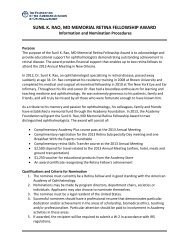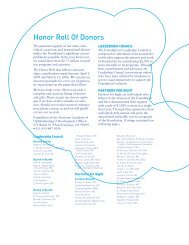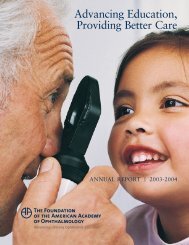C RATI - FAAO
C RATI - FAAO
C RATI - FAAO
Create successful ePaper yourself
Turn your PDF publications into a flip-book with our unique Google optimized e-Paper software.
The Museum of Vision<br />
Preserves A Doctor’s Oral History<br />
Dr. Claes H. Dohlman (b.1922) has had a<br />
long and varied career. In 1959 he founded<br />
the Cornea Service at the Massachusetts<br />
Eye and Ear Infirmary (MEEI). In 1974<br />
he was appointed Chief at MEEI, Chair of<br />
Ophthalmology at Harvard Medical School<br />
and Director of the Howe Laboratory.<br />
Before he retired from these positions,<br />
Dr. Dohlman personally trained over<br />
145 clinical fellows. He is considered a<br />
pioneer in the development of corneal<br />
transplantation and today, Dr. Dohlman<br />
still spends time seeing patients and<br />
conducting research on the development of<br />
keratoprosthesis.<br />
In 2004, Dr. Jules Baum suggested<br />
preserving the life of Dr. Dohlman through<br />
an oral history. Through our combined<br />
efforts the Academy Archives now has the<br />
remarkable story of Dr. Dohlman’s life as<br />
told in his own words.<br />
Oral histories are just one of the ways<br />
that the Museum of Vision is working to<br />
preserve the history of ophthalmology and<br />
celebrate its unique contributions to science<br />
and health.<br />
“Thank you very much for sending the [oral]<br />
history of my dear friend and highly estimated<br />
teacher in ophthalmology and corneal research,<br />
Claes Dohlman. Together with the sensitive<br />
questions of Jules Baum, it is a wonderful piece<br />
of literature.”<br />
-MARTIN REIM, MD<br />
OPHTHALMIC HERITAGE<br />
Ophthalmology and the Academy have<br />
played important roles in the history of<br />
medicine. The Foundation’s Museum of<br />
Vision preserves this history and translates<br />
it into an educational resource for use by<br />
Academy members, medical historians,<br />
researchers and the public as they seek to<br />
understand ophthalmology’s contributions<br />
to society and address similar challenges<br />
today and in the future.<br />
Last year, the Museum of Vision reached<br />
more than 595,000 people through its<br />
activities.<br />
COLLECTION<br />
Each year the museum acquires many<br />
items for its collection, including artifacts,<br />
archival materials and rare books. Each<br />
donation helps to create an interesting<br />
collection, but also one with a rich and<br />
varied background.<br />
HISTORY RESOURCE SERVICES<br />
The museum’s history resource services<br />
assist with a wide range of historical<br />
research requests. Each year Academy<br />
members and the general public take<br />
advantage of the Museum of Vision’s<br />
educational resources by directing specific<br />
inquiries to staff, conducting on-site<br />
historical research, and accessing photos.<br />
EXHIBITS<br />
Nearly 325,000 people toured the<br />
museum’s exhibits this year including our<br />
award- winning children’s exhibit entitled<br />
Animal Eyes ® . Some of the exhibit venues in<br />
2004 were our gallery at 655 Beach Street,<br />
G. Wiz Museum, the Phoenix Zoo, and the<br />
San Francisco International Airport.<br />
EDUCATIONAL RESOURCES<br />
The museum introduced more than<br />
270,000 people to the world of vision<br />
through its educational resources available<br />
to physicians, teachers, parents, and other<br />
museums interested in teaching people<br />
of all ages about the eye, vision, and the<br />
history of eye care.





